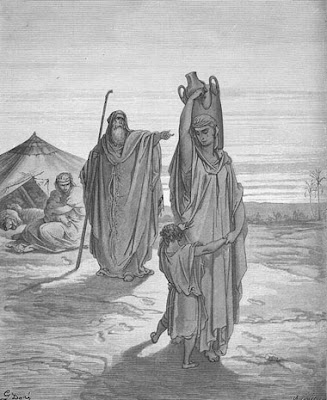Because Sarah the beloved wife of Abraham thougt she couln't become pregnant she gave her husband her Egyptian slave Hagar as a second wife. Hagar hat with Abraham a son whom she named Ishmael. With the years there aroused more and more problems between the two women. Sarah was the first, but Hagar was the mother of Abramhams son. These problems culminated after fourteen years when Sarah herself gave birth to Isaac. After new quarrels she demanded now the expulsion of Hagar and Ishmael. In the region where Abraham where living with his family this was like a death sentence. So Abraham was at first reluctant to send them into the mortal desert. But when God supported the demands of his wife and
promised to take care of Ishmael, Abraham resited no longer.
Alone in the wilderness Hagar and Ishmael ran out of water. When they where near to death an angel appeared and showed Hagar a well. Later Ishmael became the forefather of the Arab people.
In this story there are some different aspects which interested western artists. At first there is the terrible expulsion of the helpless mother and her child. The second is how the both where near to neath in the wilderness and then saved by an angel. Some artists depicts how Sarah presents Hagar to her husband, Ishmael as an archer or other scenes. But above all remain the two: the expulsion and the saving by the angel.


Paul Gustave Doré (1832–1883) was a French artist and engraver. 1866 he made the illustrations for an English Bible, from which these pictures are taken.
Dore ist not the most important artist. But as a very popular engraver his pictures are comprehensive to art history. He is using the most symbols and arangements which are typical for the paintings of better artists. There is the the exaggerated pose of Abraham, the little child - it must have been at least 16 years at this time. In the wilderness its dark, Hagar is praying like on a stage and in front there is the empty jar.
All is arranged like a scene from a silent movie.
 Salome (1896)
Salome (1896)









.jpg)












